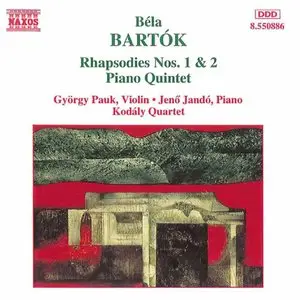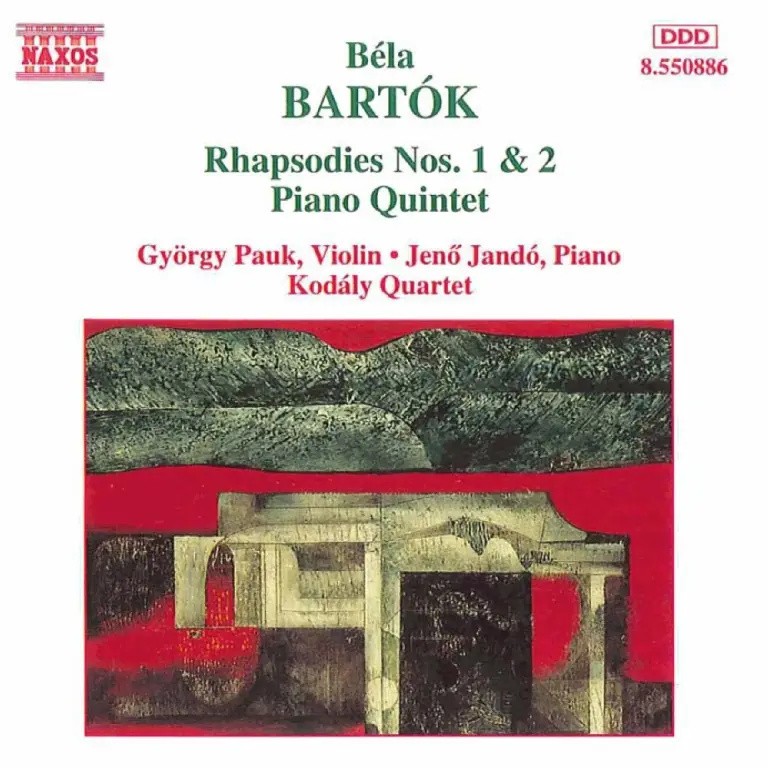Bela Bartok - Rhapsodies Nos.1 & 2, Piano Quintet
Classical | EAC: FLAC+Cue+Log | 1 Cd, Covers | 345 Mb
Label: Naxos - Date: 1995
Classical | EAC: FLAC+Cue+Log | 1 Cd, Covers | 345 Mb
Label: Naxos - Date: 1995
Through his far-reaching endeavors as composer, performer, educator, and ethnomusicolgist, Béla Bartók emerged as one of the most forceful and influential musical personalities of the twentieth century. Born in Nagyszentmiklós, Hungary (now Romania), on March 25, 1881, Bartók began his musical training with piano studies at the age of five, foreshadowing his lifelong affinity for the instrument. Following his graduation from the Royal Academy of Music in 1901 and the composition of his first mature works – most notably, the symphonic poem Kossuth (1903) – Bartók embarked on one of the classic field studies in the history of ethnomusicology. With fellow countryman and composer Zoltán Kodály, he traveled throughout Hungary and neighboring countries, collecting thousands of authentic folk songs. Bartók's immersion in this music lasted for decades, and the intricacies he discovered therein, from plangent modality to fiercely aggressive rhythms, exerted a potent influence on his own musical language.Tracks:
In addition to his compositional activities and folk music research, Bartók's career unfolded amid a bustling schedule of teaching and performing. The great success he enjoyed as a concert artist in the 1920s was offset somewhat by difficulties that arose from the tenuous political atmosphere in Hungary, a situation exacerbated by the composer's frank manner. As the specter of fascism in Europe in the 1930s grew ever more sinister, he refused to play in Germany and banned radio broadcasts of his music there and in Italy. A concert in Budapest on October 8, 1940, was the composer's farewell to the country which had provided him so much inspiration and yet caused him so much grief. Days later, Bartók and his wife set sail for America.
In his final years Bartók was beleaguered by poor health. Though his prospects seemed sunnier in the final year of his life, his last great hope – to return to Hungary – was dashed in the aftermath of World War II. He died of leukemia in New York on September 26, 1945. The composer's legacy included a number of ambitious but unrealized projects, including a Seventh String Quartet; two major works, the Viola Concerto and the Piano Concerto No. 3, were completed from Bartók's in-progress scores and sketches by his pupil, Tibor Serly.
From its roots in the music he performed as a pianist – Mozart, Beethoven, Chopin, Brahms – Bartók's own style evolved through several stages into one of the most distinctive and influential musical idioms of the first half of the twentieth century. The complete assimilation of elements from varied sources – the Classical masters, contemporaries like Debussy, folk songs – is one of the signal traits of Bartók's music. The polychromatic orchestral textures of Richard Strauss had an immediate and long-lasting effect upon Bartók's own instrumental sense, evidenced in masterpieces such as Music for Strings, Percussion, and Celesta (1936) and the Concerto for Orchestra (1945). Bartók demonstrated an especial concern with form in his exploitation and refinement of devices like palindromes, arches, and proportions based on the "golden section." Perhaps above all other elements, though, it is the ingenious application of rhythm that gives Bartók's music its keen edge. Inspired by the folk music he loved, Bartók infused his works with asymmetrical, sometimes driving, often savage, rhythms, which supply violent propulsion to works such as Allegro barbaro (1911) and the Sonata for Two Pianos and Percussion (1937). If a single example from Bartók's catalogue can be regarded as representative, it is certainly the piano collection Mikrokosmos (1926-1939), originally intended as a progressive keyboard primer for the composer's son, Peter. These six volumes, comprising 153 pieces, remain valuable not only as a pedagogical tool but as an exhaustive glossary of the techniques – melodic, harmonic, rhythmic, formal – that provided a vessel for Bartók's extraordinary musical personality.From Allmusic
01. Rhapsody No.1: I. Prima parte "Iassu"- Moderato [0:04:38.08]
02. II. Seconda Parte "friss"- Allegretto moderato [0:05:43.57]
03. Rhapsody No.2: I. Prima parte "lassu"- Moderato [0:04:17.25]
04. Seconda parte "friss"- Allegro moderato [0:06:48.45]
05. Andante (1902) [0:03:24.18]
06. Piano Quintet: I. Andante [0:13:07.57]
07. II. Vivace (Scherzando) [0:08:47.25]
08. III. Adagio [0:11:26.05]
09. IV. Poco a poco piu vivace [0:08:23.38]
Exact Audio Copy V1.0 beta 3 from 29. August 2011
EAC extraction logfile from 19. April 2012, 23:27
Bela Bartok / Rhapsodies Nos.1 & 2, Piano Quintet
Used drive : TSSTcorpCD/DVDW TS-H552B Adapter: 3 ID: 1
Read mode : Secure
Utilize accurate stream : Yes
Defeat audio cache : Yes
Make use of C2 pointers : No
Read offset correction : 12
Overread into Lead-In and Lead-Out : No
Fill up missing offset samples with silence : Yes
Delete leading and trailing silent blocks : No
Null samples used in CRC calculations : Yes
Used interface : Native Win32 interface for Win NT & 2000
Used output format : User Defined Encoder
Selected bitrate : 896 kBit/s
Quality : High
Add ID3 tag : No
Command line compressor : C:\Program Files (x86)\Exact Audio Copy\Flac\flac.exe
Additional command line options : -V -0 -T "artist=%artist%" -T "title=%title%" -T "album=%albumtitle%" -T "date=%year%" -T "tracknumber=%tracknr%" -T "genre=%genre%" %source%
TOC of the extracted CD
Track | Start | Length | Start sector | End sector
––––––––––––––––––––––––––––-
1 | 0:00.32 | 4:38.08 | 32 | 20889
2 | 4:38.40 | 5:43.57 | 20890 | 46671
3 | 10:22.22 | 4:17.25 | 46672 | 65971
4 | 14:39.47 | 6:48.45 | 65972 | 96616
5 | 21:28.17 | 3:24.18 | 96617 | 111934
6 | 24:52.35 | 13:07.57 | 111935 | 171016
7 | 38:00.17 | 8:47.25 | 171017 | 210566
8 | 46:47.42 | 11:26.05 | 210567 | 262021
9 | 58:13.47 | 8:23.38 | 262022 | 299784
Range status and errors
Selected range
Filename F:\Musique\Bartok\Rhapsodies_Piano_Quintet\Bela Bartok - Rhapsodies Nos.1 & 2, Piano Quintet.wav
Peak level 98.8 %
Extraction speed 10.5 X
Range quality 100.0 %
Test CRC 41C2E248
Copy CRC 41C2E248
Copy OK
No errors occurred
AccurateRip summary
Track 1 accurately ripped (confidence 10) [63CAAC85] (AR v1)
Track 2 accurately ripped (confidence 10) [C7E7E703] (AR v1)
Track 3 accurately ripped (confidence 10) [38467E2D] (AR v1)
Track 4 accurately ripped (confidence 10) [9C42CE21] (AR v1)
Track 5 accurately ripped (confidence 10) [2EC077BC] (AR v1)
Track 6 accurately ripped (confidence 9) [F197B657] (AR v1)
Track 7 accurately ripped (confidence 9) [05257F9B] (AR v1)
Track 8 accurately ripped (confidence 10) [CDFC498A] (AR v1)
Track 9 accurately ripped (confidence 10) [448DB6C1] (AR v1)
All tracks accurately ripped
End of status report
==== Log checksum F675930B8CED77C24DE583616CE87825D0B4820D615A75EA0202DF5DD3651951 ====



